Women in the House of Commons of the United Kingdom
The representation of Women in the House of Commons of the United Kingdom has been an issue in the politics of the United Kingdom at numerous points in the 20th and 21st centuries. Originally debate centred on whether women should be allowed to vote and stand for election as Members of Parliament. The Parliament (Qualification of Women) Act 1918 gave women over 21 the right to stand for election as a Member of Parliament. The United Kingdom has had two female Prime Ministers: Margaret Thatcher (1979-1990) and Theresa May (2016–2019). The publication of the book Women in the House by Elizabeth Vallance in 1979 highlighted the under-representation of women in Parliament.[1] In more modern times concerns about the under-representation of women led the Labour Party to introduce all-women short lists, something which was later held to breach discrimination laws.

Between 1918 and 2019, a total of 552 women have been elected as Members of the House of Commons. As of June 2020 there are 220 women in the House of Commons, the highest ever. This is a new all-time high at 34% and is the first time that female representation in the House of Commons is at more than a third.[2] The previous number was 208, set in 2017, which accounted for 32% of members elected or re-elected that year.[3] Additionally, at the 2019 general election more female than male Labour MPs were elected or re-elected (104 women out of 202 MPs in total) - the first time in Labour's history that this has happened.[4][5] The female member of Parliament with the longest period of continuous service is currently informally known as the Mother of the House.
Suffrage
In 1832 Henry Hunt became the first MP to raise the issue of women's suffrage in the House of Commons,[6] followed in 1867 by John Stuart Mill. Following this attempts were made to widen the franchise in every Parliament.[7]
Women gained the right to vote with the passing of the Representation of the People Act 1918 after World War I. This gave the vote to women over the age of 30. However, the Speakers Conference which was charged with looking into giving women the vote did not have as its terms of reference, consideration to women standing as candidates for Parliament. However, Sir Herbert Samuel, the former Liberal Home Secretary, moved a separate motion on 23 October 1918 to allow women to be eligible as Members of Parliament. The vote was passed by 274 to 25 and the government rushed through a bill to make it law in time for the 1918 general election.[8] This bill did not specify any age restriction, unlike the voting bill.[9] This later led to a number of incidents of women under the age of 30, who were not allowed to vote, standing for Parliament, notably the 27-year-old Liberal Ursula Williams standing in 1923.[10]
Landmarks and records
Political firsts for women in House of Commons
- 1918: Women able to stand for Parliament.
- 1918: First woman elected to Parliament (Constance Markievicz). However as a member of Sinn Féin, she did not take her seat.[11] Markievicz also became the only woman to represent an Irish constituency in Parliament until 1922 and the first female member who, before the election, chose to become a Catholic.[12]
- 1919: Member of Parliament to take her seat (Nancy Astor) – for Coalition Conservatives
- 1921: British-born member to take her seat (Margaret Wintringham) – Liberal Party
- 1924: Minister (Margaret Bondfield) – for Labour Party
- 1926: Member to represent more than one constituency in non-consecutive terms (Margaret Bondfield) – Labour Party
- 1929: Cabinet minister and privy counsellor (Margaret Bondfield)
- 1929: Female Baby of the House (Jennie Lee) – Labour Party
- 1929: Independent member elected (Eleanor Rathbone)
- 1929: Non-Christian elected (Marion Phillips) – Labour Party
- 1929: Shortest-serving member (Ruth Dalton) – Labour Party; equalled in 1974 by Margo MacDonald – SNP
- 1931: Member to cross the floor (Cynthia Mosley) – from Labour to New Party
- 1931: Member to die in office and oldest woman elected (Ethel Bentham) – Labour Party
- 1938: Resignation from the House, i.e. appointment to a stewardship (The Duchess of Atholl) – Unionist Party
- 1948: Chair of Committee of Whole House (Florence Paton) – Labour Party
- 1948: British-born Catholic (Alice Cullen) – Labour Party
- 1953: Member from Northern Ireland; first Irishwoman to take her seat (Patricia Ford) – Ulster Unionist Party
- 1965: Parliamentary Whip (Harriet Slater) – Labour Party
- 1970: Deputy speaker (Betty Harvie Anderson) – Conservative Party
- 1974: Youngest woman to leave the House (Bernadette Devlin McAliskey) – Independent Socialist
- 1975: Leader of the Opposition (Margaret Thatcher)
- 1976: Member outed as LGBT (Maureen Colquhoun) – Labour Party
- 1979: Prime Minister (Margaret Thatcher) who led the Conservative Party from 1975 to 1990.
- 1987: Member from ethnic or racial minorities (Diane Abbott) – Labour Party
- 1992: Speaker of the House of Commons (Betty Boothroyd) – Labour Party. As of 2019 she remains the only female to hold the office of House Speaker.
- 1997: Full-time Minister for Women (Joan Ruddock) – Labour Party
- 1997: Member who came out as LGBT in office (Angela Eagle) – Labour Party
- 1998: Chief Whip (Ann Taylor)[3] – Labour Party
- 2010: LGBT member elected (Margot James) – Conservative Party
- 2010: Minor party members elected (Caroline Lucas – Green Party of England and Wales; Naomi Long – Alliance Party of Northern Ireland)
- 2015: Youngest woman elected (Mhairi Black) – SNP
- 2016: Cabinet minister to come out in office (Justine Greening)[13] – Conservative Party
- 2016: Member to be assassinated (Jo Cox) – Labour Party. She became also the first Labour MP to die as a crime victim.
- 2019: Non-Christian by choice of conversion elected (Charlotte Nichols)[14] – Labour Party
- 2019: Oldest woman to leave the House (Ann Clwyd) – Labour Party
Records
Margaret Beckett is the longest serving female MP in the history of the House of Commons. She was an MP for Lincoln from 10 October 1974 until 7 April 1979, and has served as MP for Derby South since 9 June 1983, most recently being re-elected on 12 December 2019.
Harriet Harman is the longest continuously serving female MP in the history of the House of Commons. She was MP for Peckham from 28 October 1982 until 1 May 1997, and has served as MP for Camberwell and Peckham since 1 May 1997, most recently having been re-elected on 12 December 2019. On 13 June 2017 Harman was dubbed "Mother of the House" by Prime Minister Theresa May, in recognition of her status as longest continuously serving woman MP (though she was not the longest serving MP overall, and would therefore not gain any official duties).
| Party | Name | Constituency | Year elected | Year left | Length of continuous term | Length of cumulative term | |
|---|---|---|---|---|---|---|---|
| Conservative | Nancy Astor [15] | Plymouth Sutton | 1919 | 1945 | 25 years, 7 months | ||
| Labour | Jennie Lee [16][17] | North Lanarkshire & Cannock | 1929 & 1945 | 1931 & 1970 | 27 years | ||
| Conservative | Irene Ward [18] | Wallsend & Tynemouth | 1931 & 1950 | 1945 & 1974 | 37 years | ||
| Labour | Barbara Castle [19] | Blackburn | 1945 | 1979 | 33 years, 9 months | ||
| Conservative | Margaret Thatcher [20] | Finchley | 1959 | 1992 | 33 years, 6 months | ||
| Labour | Gwyneth Dunwoody [21] | Exeter, Crewe & Crewe and Nantwich | 1966 & 1974 | 1970 & 2008 | 34 years, 2 months | 37 years, 9 months | |
| Labour | Margaret Beckett [22] | Lincoln & Derby South | 1974 & 1983 | 1979 & Still serving | 41 years, 9 months and 6 days (Derby South) | 46 years, 1+ month | |
| Labour | Harriet Harman [23] | Peckham, then Camberwell and Peckham | 1982 | Still serving | 38 years, 3 months and 12 days | ||
Current representation
As of December 2019, there are 220 female MPs in the House of Commons.
| Political party |
Number of MPs | Number of female MPs | Percentage of party's MPs | Percentage of female MPs | |
|---|---|---|---|---|---|
| House of Commons[2] | 650 | 220 | 34% | 100% | |
| Conservative | 365 | 87 | 24% | 40% | |
| Labour | 202 | 104 | 51% | 47% | |
| SNP | 49 | 16 | 33% | 7% | |
| Liberal Democrats | 11 | 7 | 64% | 3% | |
| DUP | 8 | 1 | 13% | <1% | |
| Sinn Féin | 7 | 2 | 29% | 1% | |
| Plaid Cymru | 3 | 1 | 33% | <1% | |
| SDLP | 2 | 1 | 50% | <1% | |
| Green | 1 | 1 | 100% | <1% | |
| Alliance | 1 | 0 | 0% | 0% | |
| Independent | 1 | 0 | 0% | 0% | |
| Speaker |
1 | 0 | 0% | 0% |
In February 2018 the Electoral Reform Society reported that hundreds of seats were being effectively 'reserved' by men, holding back women’s representation. Their report states that 170 seats are being held by men first elected in 2005 or before – with few opportunities for women to take those seats or selections. Broadly speaking, the longer an MP has been in Parliament, the more likely they are to be male.[24][25]
| MP for this seat since: | Total | Female | Male | % F | % M |
|---|---|---|---|---|---|
| 2001 or before | 143 | 21 | 122 | 14.7% | 85.3% |
| 2005 or before | 212 | 42 | 170 | 19.8% | 80.2% |
| 2010 or before | 380 | 93 | 287 | 24.5% | 75.5% |
| 2015 or before | 545 | 167 | 378 | 30.6% | 69.4% |
| 2018 or before | 650 | 208 | 442 | 32.0% | 68.0% |
| 2019 (all MPs)[2] | 650 | 220 | 430 | 33.9% | 66.1% |
Current female Cabinet members (Conservative Party)
- Liz Truss – Secretary of State for International Trade/President of the Board of Trade
- Thérèse Coffey – Secretary of State for Work and Pensions
- Baroness Evans of Bowes Park – Leader of the House of Lords
- Priti Patel – Secretary of State for the Home Department
- Amanda Milling – Minister without Portfolio/Party Chair
Historic representation
2017 election
In the 2017 general election, 208 women were elected, making up 32% of the House of Commons, up from 191 and 29% before the election.[3]
| Political party |
Number of MPs | Number of female MPs | Percentage of party's MPs | Percentage of female MPs | |
|---|---|---|---|---|---|
| House of Commons | 650 | 208 | 32% | 100% | |
| Conservative | 317 | 67 | 21% | 32% | |
| Labour | 262 | 119 | 45% | 57% | |
| SNP | 35 | 12 | 34% | 6% | |
| Liberal Democrats | 12 | 4 | 33% | 2% | |
| DUP | 10 | 1 | 10% | <1% | |
| Sinn Féin | 7 | 2 | 29% | <1% | |
| Plaid Cymru | 4 | 1 | 25% | <1% | |
| Green | 1 | 1 | 100% | <1% | |
| Independent | 1 | 1 | 100% | <1% | |
| Speaker |
1 | 0 | 0% | 0% |
Female Cabinet members appointed after the 2017 election
- Theresa May – Prime Minister
- Liz Truss – Secretary of State for International Trade/President of the Board of Trade
- Thérèse Coffey – Secretary of State for Work and Pensions (2019)
- Baroness Evans of Bowes Park – Leader of the House of Lords
- Penny Mordaunt – Secretary of State for Defence
- Karen Bradley – Secretary of State for Northern Ireland
- Andrea Leadsom – Secretary of State for Business, Energy and Industrial Strategy
- Priti Patel – Secretary of State for the Home Department
- Theresa Villiers – Secretary of State for Environment, Food and Rural Affairs
- Nicky Morgan – Secretary of State for Digital, Culture, Media and Sport
- Esther McVey – Secretary of State for Work and Pensions (2018)
- Amber Rudd – Secretary of State for Work and Pensions (2018–19)
2015 election
In the 2015 general election, 191 women were elected, making up 29% of the House of Commons, up from 141 and 23% before the election.[26]
| Political party |
Number of MPs | Number of female MPs | Percentage of party's MPs | Percentage of female MPs | |
|---|---|---|---|---|---|
| House of Commons | 650 | 191 | 29% | 100% | |
| Conservative | 330 | 68 | 21% | 36% | |
| Labour | 232 | 99 | 43% | 52% | |
| SNP | 56 | 20 | 36% | 10% | |
| Liberal Democrats | 8 | 0 | 0% | 0% | |
| DUP | 8 | 0 | 0% | 0% | |
| Sinn Féin | 4 | 0 | 0% | 0% | |
| Plaid Cymru | 3 | 1 | 33% | <1% | |
| SDLP | 3 | 1 | 33% | <1% | |
| UUP | 2 | 0 | 0% | 0% | |
| UKIP | 1 | 0 | 0% | 0% | |
| Green | 1 | 1 | 100% | <1% | |
| Independent | 1 | 1 | 100% | <1% | |
| Speaker |
1 | 0 | 0% | 0% |
Female Cabinet members appointed after the 2015 election
- Theresa May – Secretary of State for the Home Department
- Justine Greening – Secretary of State for International Development
- Nicky Morgan – Secretary of State for Education and Minister for Women and Equalities
- Baroness Stowell of Beeston – Leader of the House of Lords
- Theresa Villiers – Secretary of State for Northern Ireland
- Liz Truss – Secretary of State for Environment, Food and Rural Affairs
- Amber Rudd – Secretary of State for Energy and Climate Change
2010 election
As elected in the 2010 general election.
| Political party |
Number of MPs | Number of female MPs | Percentage of party's MPs | Percentage of female MPs | |
|---|---|---|---|---|---|
| House of Commons | 650 | 143 | 22% | 100% | |
| Conservative | 306 | 49 | 16% | 34% | |
| Labour | 258 | 81 | 31% | 57% | |
| Liberal Democrats | 57 | 7 | 12% | 5% | |
| DUP | 8 | 0 | 0% | 0% | |
| SNP | 6 | 1 | 17% | 0.7% | |
| Sinn Féin | 5 | 1 | 20% | 0.7% | |
| Plaid Cymru | 3 | 0 | 0% | 0% | |
| SDLP | 3 | 1 | 33% | 0.7% | |
| Alliance | 1 | 1 | 100% | 0.7% | |
| Green | 1 | 1 | 100% | 0.7% | |
| Independent | 1 | 1 | 100% | <1% | |
| Speaker |
1 | 0 | 0% | 0% |
Female Cabinet members appointed after the 2010 election
- Theresa May – Secretary of State for the Home Department
- Caroline Spelman – Secretary of State for Environment, Food and Rural Affairs
- Cheryl Gillan – Secretary of State for Wales
- Baroness Warsi – Minister without Portfolio
A total of 46 female ministers have held Cabinet positions since the first, Margaret Bondfield, in 1929. Tony Blair’s 1997 Cabinet had five women and was the first to include more than two female ministers at one time. The highest number of concurrent women Cabinet ministers under Tony Blair was eight (36 per cent), under Tony Blair (then a record) from May 2006 – May 2007. Other women have attended Cabinet without being full members, including Caroline Flint, Anna Soubry and Caroline Nokes. Some who have attended Cabinet have subsequently, or previously been full Cabinet Ministers, including Tessa Jowell, Liz Truss and Andrea Leadsom.
| Women Cabinet Ministers 1929–present | |||
|---|---|---|---|
| 1929-31 | Margaret Bondfield (Lab) |  | |
| 1945-47 | Ellen Wilkinson (Lab) |  | |
| 1953-54 | Florence Horsbrugh (Con) |  | |
| 1964-70/74-76 | Barbara Castle (Lab) |  | |
| 1968-69 | Judith Hart (Lab) |  | |
| 1970-74/79-90 | Margaret Thatcher (Con) |  | |
| 1974-79 | Shirley Williams (Lab) | .jpg.webp) | |
| 1982-83 | Baroness Young (Con) |  | |
| 1992-97 | Gillian Shephard (Con) |  | |
| 1992-97 | Virginia Bottomley (Con) | 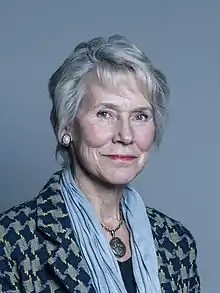 | |
| 1997-2007 (attended Cabinet 2008-09) |
Margaret Beckett (Lab) |  | |
| 1997-2001 | Ann Taylor (Lab) |  | |
| 1997-98/2007-10 | Harriet Harman (Lab) |  | |
| 1997-2001 | Mo Mowlam (Lab) |  | |
| 1997-2003 | Clare Short (Lab) |  | |
| 1998-2001 | Baroness Jay of Paddington (Lab) |  | |
| 2001-03 | Helen Liddell (Lab) |  | |
| 2001-02 | Estelle Morris (Lab) |  | |
| 2001-07 | Hilary Armstrong (Lab) | 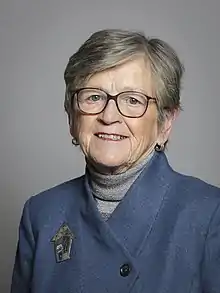 | |
| 2001-07 | Patricia Hewitt (Lab) |  | |
| 2001-07/09-10 (attended Cabinet 2007-09) |
Tessa Jowell (Lab) |  | |
| 2003-07 | Baroness Amos (Lab) |  | |
| 2004-08 | Ruth Kelly (Lab) |  | |
| 2006-09 | Hazel Blears (Lab) |  | |
| 2006-09 | Jacqui Smith (Lab) | 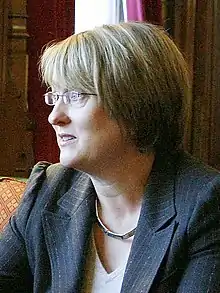 | |
| 2007-08 | Cathy Baroness Ashton of Upholland (Lab) | .jpg.webp) | |
| 2008-10 | Yvette Cooper (Lab) |  | |
| 2008-10 | Baroness Royall of Blaisdon (Lab) | 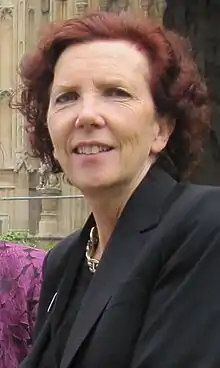 | |
| 2010-12 | Caroline Spelman (Con) |  | |
| 2010-12 | Cheryl Gillan (Con) |  | |
| 2010-12 | Baroness Warsi (Con) | .jpg.webp) | |
| 2010-19 | Theresa May (Con) | _(cropped).jpg.webp) | |
| 2011-18 | Justine Greening (Con) |  | |
| 2012-14 | Maria Miller (Con) |  | |
| 2012-16/19-20 | Theresa Villiers (Con) |  | |
| 2014-16 (as Nicky Morgan)/19–20 | Baroness Morgan of Cotes (Con) |  | |
| 2014-17/19- (attended Cabinet 2017-19) |
Elizabeth Truss (Con) |  | |
| 2014-16 | Baroness Stowell of Beeston (Con) | 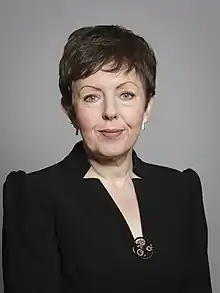 | |
| 2015-18/18-19 | Amber Rudd (Con) |  | |
| 2016- | Baroness Evans of Bowes Park (Con) |  | |
| 2016-19 | Karen Bradley (Con) |  | |
| 2016-17/19-20 (attended Cabinet 2017-19) |
Andrea Leadsom (Con) |  | |
| 2016-17/19- | Priti Patel (Con) |  | |
| 2017–19 | Penny Mordaunt (Con) |  | |
| 2018/19 (attended Cabinet 2019–20) |
Esther McVey (Con) |  | |
| 2019- | Thérèse Coffey (Con) |  | |
| 2020 | Anne-Marie Trevelyan (Con) |  | |
| 2020- | Amanda Milling (Con) |  | |
| Women junior ministers in the Cabinet | |||
|---|---|---|---|
| 1968-69 | Judith Hart (Lab) | ||
| 2007-09 | Caroline Flint (Lab) |  | |
| 2007-09 | Beverley Hughes (Lab) |  | |
| 2007-10 | Baroness Scotland of Asthal (Lab) |  | |
| 2009-10 | Dawn Primarolo (Lab) |  | |
| 2009-10 | Rosie Winterton (Lab) |  | |
| 2014-16 | Baroness Anelay of St Johns (Con) |  | |
| 2015-16 | Anna Soubry (Con) |  | |
| 2018-19 | Caroline Nokes (Con) |  | |
| 2018-19 | Claire Perry (Con) |  | |
| 2020- | Suella Braverman (Con) |  | |
All-women shortlists
All-women shortlists are a method of affirmative action which has been used by the Labour Party to increase the representation of women in Parliament. As of 2015, 117 Labour MPs have been elected to the House of Commons after being selected as candidates through an all-women shortlist.[29] In 2002 this method of selection was ruled to breach the Sex Discrimination Act 1975. In response to this ruling the Sex Discrimination (Election Candidates) Act 2002 legalised all-women short lists as a method of selection. The Equality Act 2010 extends this exemption from discrimination law to 2030.
See also
- Blair Babe
- Election results of women standing for the Parliament of the United Kingdom (to 1945)
- List of female Members of the House of Commons of the United Kingdom
- Lists of female political office-holders in the United Kingdom
- Timeline of female MPs in the House of Commons
- Widow's succession
- Women in the House of Lords
- European countries by percentage of women in national parliaments
- Women in positions of power
- Critical mass (gender politics)
- Women Political Leaders
- Women in government
References
- Heater, Derek (2006). Citizenship in Britain: A History. Edinburgh University Press. p. 145. ISBN 9780748626724.
- Busby, Pamela; Busby, Mattha (13 December 2019). "UK elects record number of female MPs". The Guardian. Retrieved 14 December 2019.
- Elise Uberoi; Alexander Bellis; Edward Hicks; Steven Browning (25 September 2019). "Women in Parliament and Government". House of Commons Library. Retrieved 13 December 2019. Cite journal requires
|journal=(help) - "State of the parties". members.parliament.uk. Retrieved 5 June 2020.
- Elliot Chappell (31 December 2019). "51% of Labour MPs are women. What now for all-women shortlists?". LabourList. Retrieved 5 June 2020.
- "Women and the vote: Orator Hunt and the first suffrage petition 1832". www.parliament.uk. Retrieved 5 June 2020.
- "Women in parliament". BBC News. London: BBC. 31 October 2008. Retrieved 21 June 2015.
- Samuel, Viscount (1950). Memoirs. p. 131.
- "Parliament (Qualification Of Women) Bill". Parliamentary Debates (Hansard). House of Commons. 6 November 1918. col. 2186–2202. Retrieved 21 June 2015.
- Cheltenham Chronicle, Gloucestershire, 8 December 1923
- "Women in the House of Commons". Parliament.uk. Retrieved 24 October 2019.
- "9 facts about Constance Markievicz: Incredible Irishwoman who fought in Easter Rising and became first-ever female MP". Irish Post. 5 February 2018.
- Wilkinson, Michael; Mendick, Robert (25 June 2016). "Pro-EU minister Justine Greening reveals she is gay at London Pride saying 'sometimes you are better off out'". The Telegraph. ISSN 0307-1235. Retrieved 22 March 2020.
- "Jewish Labour candidate: Party's antisemitism problem is 'more nuanced' than is alleged". The Jewish Chronicle. 9 December 2019. Archived from the original on 30 December 2019.
- CH. Succeeded her husband Waldorf Astor, 2nd Viscount Astor as MP after he became a member of the House of Lords due to inheriting the title of Viscount Astor upon the death of his father.
- Married to fellow MP Anuerin Bevan. She was made a life peer as Baroness Lee of Asheridge, of the City of Westminster in 1970.
- "No. 45229". The London Gazette. 10 November 1970. p. 12333.
- CH, DBE. She was made a life peer as Baroness Ward of North Tyneside, of North Tyneside in the County of Tyne and Wear, in 1975.
- Wife of Edward Castle, Baron Castle. She was made a life peer as Baroness Castle of Blackburn, in 1990.
- CH. She was made a life peer as Baroness Thatcher in 1992.
- Daughter of Morgan Phillips & Norah Phillips, Baroness Phillips. Mother of Tamsin Dunwoody.
- DBE
- QC
- Martin, George (13 February 2018). "Male MPs are 'blocking' the safe seats – forcing women to fight marginals". i. Retrieved 16 February 2018.
- "Hundreds of seats effectively 'reserved' by men at Westminster, research shows". electoral-reform.org.uk. Electoral Reform Society. 13 February 2018. Retrieved 16 February 2018.
- Lowther, Ed; Thornton, Charlotte (8 May 2015). "Election 2015: Number of women in Parliament rises by a third". BBC News. Retrieved 4 October 2017.
- "Members of the House of Commons". UK Parliament. 2015. Retrieved 21 June 2015.
- "Factsheet M4: Women in the House of Commons" (PDF). House of Commons Information Office. June 2010. Retrieved 21 June 2015.
- Kelly, Richard; White, Isobel (7 March 2016). "All-women shortlists". Retrieved 19 November 2016. Cite journal requires
|journal=(help)
Further reading
- "Women in the House of Commons inquiry". Women and Equalities Committee. Retrieved 4 October 2017.
- "Women in the House of Commons (archieved factsheets)". House of Commons Information Office, House of Commons Library. Retrieved 4 October 2017.
- Vallance, Elizabeth M. (1979). Women in the House: a study of women Members of Parliament. Athlone Press. ISBN 9780485111866.
- All Party Parliamentary Group Women in Parliament (July 2014). "Improving Parliament: Creating a Better and More Representative House" (PDF). House of Commons. Retrieved 21 June 2015.
- "Harman's office Thatcher U-turn". BBC News. London: BBC. 16 September 2009. Retrieved 21 June 2015.
- "Women in Parliament and Government". House of Commons Library. 25 September 2019. Cite journal requires
|journal=(help)
External links
- "Parliament and Women". UK Parliament website.
- "Women in the House of Commons". UK Parliament website.
- "Women and the House of Lords". UK Parliament website.
- "Campaigning for women in the Lords". UK Parliament website.
- "Accommodating women peers". UK Parliament website.